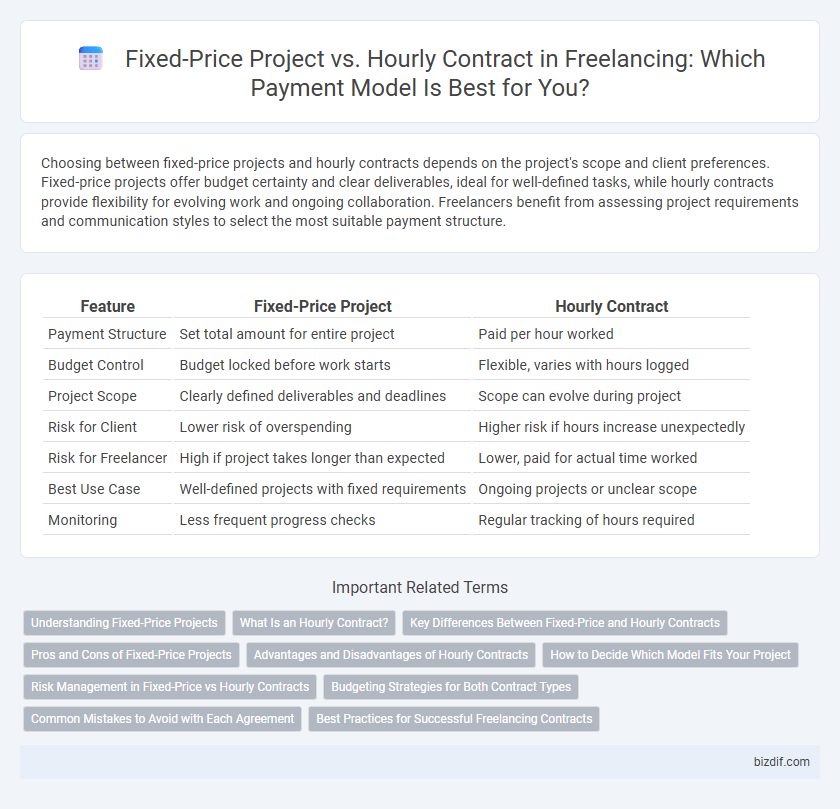Choosing between fixed-price projects and hourly contracts depends on the project's scope and client preferences. Fixed-price projects offer budget certainty and clear deliverables, ideal for well-defined tasks, while hourly contracts provide flexibility for evolving work and ongoing collaboration. Freelancers benefit from assessing project requirements and communication styles to select the most suitable payment structure.
Table of Comparison
| Feature | Fixed-Price Project | Hourly Contract |
|---|---|---|
| Payment Structure | Set total amount for entire project | Paid per hour worked |
| Budget Control | Budget locked before work starts | Flexible, varies with hours logged |
| Project Scope | Clearly defined deliverables and deadlines | Scope can evolve during project |
| Risk for Client | Lower risk of overspending | Higher risk if hours increase unexpectedly |
| Risk for Freelancer | High if project takes longer than expected | Lower, paid for actual time worked |
| Best Use Case | Well-defined projects with fixed requirements | Ongoing projects or unclear scope |
| Monitoring | Less frequent progress checks | Regular tracking of hours required |
Understanding Fixed-Price Projects
Fixed-price projects in freelancing involve a predetermined budget agreed upon before work begins, ensuring costs remain constant regardless of time spent. This model is ideal for well-defined tasks with clear deliverables, minimizing financial uncertainty for clients. Freelancers benefit from fixed-price projects by managing scope carefully and optimizing efficiency to maximize profitability.
What Is an Hourly Contract?
An hourly contract in freelancing is a payment structure where clients compensate freelancers based on the actual hours worked, tracked through time-logging tools or manual reports. This model offers flexibility for projects with evolving scopes, ensuring freelancers are paid accurately for time invested. Hourly contracts are ideal for ongoing tasks, maintenance work, or projects where deliverables are not clearly defined at the outset.
Key Differences Between Fixed-Price and Hourly Contracts
Fixed-price projects define a set budget and timeline, providing clarity and limited financial risk for both freelancers and clients, while hourly contracts bill based on actual hours worked, offering flexibility and potential for project scope changes. Fixed-price contracts require detailed project specifications upfront, whereas hourly contracts accommodate evolving tasks without renegotiation. Choosing between these models depends on project predictability, client trust, and freelancer preference for risk versus reward.
Pros and Cons of Fixed-Price Projects
Fixed-price projects offer clear budget expectations and defined deliverables, which help freelancers manage time efficiently and clients control costs. However, the inflexibility can lead to scope creep challenges and insufficient compensation for extra work if project requirements change. This contract type demands precise project scopes and risk management to avoid disputes and ensure mutual satisfaction.
Advantages and Disadvantages of Hourly Contracts
Hourly contracts offer flexibility in project scope and allow freelancers to be compensated for all their time, making them ideal for tasks with uncertain durations or evolving requirements. These contracts provide transparency for clients through detailed time tracking but can lead to unpredictable earnings and potential disputes over hours logged. Freelancers benefit from continuous income flow but may face challenges in time management and client trust.
How to Decide Which Model Fits Your Project
Choosing between a fixed-price project and an hourly contract depends on the project's scope, budget certainty, and required flexibility. Fixed-price models suit well-defined projects with clear deliverables and deadlines, ensuring predictable costs. Hourly contracts are ideal for evolving tasks or ongoing work where scope may change, providing adaptability and transparent billing based on actual time spent.
Risk Management in Fixed-Price vs Hourly Contracts
Fixed-price projects offer clear budget boundaries, reducing the risk of unexpected cost overruns but increase the risk of scope creep if requirements are not well-defined upfront. Hourly contracts provide flexibility to adjust to project changes, minimizing scope risk but can lead to budget uncertainty and higher financial exposure. Effective risk management requires detailed project planning and transparent communication to balance cost control in fixed-price contracts and time tracking in hourly agreements.
Budgeting Strategies for Both Contract Types
Fixed-price projects require precise budget planning by defining clear project scopes and deliverables to avoid scope creep and unexpected costs. Hourly contracts demand continuous tracking of time and resources, allowing flexible adjustments but necessitating transparent communication to control expenses. Effective budgeting strategies combine thorough initial estimates for fixed-price contracts with real-time monitoring and regular updates for hourly agreements to maintain financial control.
Common Mistakes to Avoid with Each Agreement
Fixed-price projects often suffer from scope creep due to poorly defined deliverables and unrealistic deadlines, leading to missed expectations and budget overruns. Hourly contracts commonly face errors like inaccurate time tracking and insufficient communication about work progress, resulting in client dissatisfaction and payment disputes. Clear documentation, transparent communication, and setting detailed boundaries help mitigate these mistakes in both fixed-price and hourly freelancing agreements.
Best Practices for Successful Freelancing Contracts
Defining clear deliverables and milestones is essential for successful fixed-price projects to ensure mutual understanding and prevent scope creep. Hourly contracts require transparent time tracking and regular communication to maintain trust and justify billing accuracy. Establishing detailed contracts that outline payment terms, deadlines, and revision policies minimizes conflicts and promotes professional relationships in both pricing models.
Fixed-Price Project vs Hourly Contract Infographic

 bizdif.com
bizdif.com